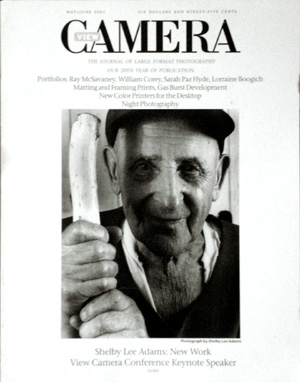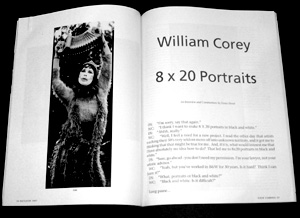Article and commentary courtesy of Dana Strout and View Camera Magazine.
“I’m sorry, say that again.”
“I think I want to make 8 X 20 portraits in black and white.”
“Ahhh, really.”
“Well, I feel like I need a new project. I read the other day that artists in their 50’s very seldom move off into unknown territory and it got me to thinking that that might be true for me and, if it is, what would interest me that I have absolutely no idea how to do, which led me to 8 X 20 portraits in black and white.”

“Sure, go ahead — you don’t need my permission. I’m your lawyer, not your artistic advisor.”
“Yes, but you’ve worked in B&W for 30 years. Is it hard, think I can learn it?”
“What portraits or black and white.”
“Black and white. Is it difficult?”
Long pause…
“Naw, just read Ansel’s book on the zone system. It’s the best place to start. You’ll be okay.”
“You’re joking right?”
“No, read it, it’s the black and white bible, you know expose for the shadows, develop until your highlights are right, you’ve heard all that.”

“Okay, I’ll read it, but what else will get me started? I know nothing about black and white. I’ve never taken a black and white photograph. I see in color; I have always worked in color; I print in color. I don’t know the first thing about photographing in shades of gray.”
“Okay, what do you want to know?”
“First of all, what film and developer should I use? The lab tells me that they want nothing to do with developing 8 x 20 film. I’m going to have to learn to do it myself.”
“Go to the Bostick & Sullivan web site; they sell ultra large format film, they’ll tell you what you need to know. You’ve never exposed a black and white negative?”
“Nope”
“Look, this stuff is not necessarily difficult, just a lot to digest. But… the black and white world is full of people who will talk to you for hours about this stuff, who will send you formulas and everything you need and then some. Just do this… call B & S for help, they’ll tell you what large film and developers are available, how they work and what you need to get going. And… good luck!”
This conversation occurred about three years ago, when I received a call from my close friend and fellow photographer, William Corey. William is one of the pre-eminent photographers of Japanese gardens in the world. He was the first western artist ever given permission to photograph the private gardens of the Emperor of Japan. In 1994, when the Emperor and Empress visited the United States, the Japanese ambassador made a private visit to his studio to ask if he would make a special photograph of Rocky Mountain National Park in his home state of Colorado and present it to the royal family at a reception at the Governors mansion in Denver. You have only to look at a few of his prints of Japanese gardens to realize that he is a true master of this world. The depth and fidelity of his images is staggering.
But a series of life events had interrupted Corey’s Japanese work and he found himself at his home in Colorado and not photographing. He had worked for years with an 8 X 20 Korona-Morris ultra large format view camera, with an 18″ Ektar lens and DeGolden Busch holders using Fuji color film. Now, the color negative film he favored was getting harder to come by, photo labs that could process the large films were going out of business left and right, analog was on its way out and the digital darkroom was in its infancy. Plus he was seeking a different challenge. What to do?
And, so, one fine day I received a call at my office which went something like the above. Well, call Bostick & Sullivan he did, and he spent hours on the phone with Kevin Sullivan, who told him how to do what he had never even considered doing before, exposing and developing large sheets of black and white film in old formula pyro developers. From time to time we would talk and every conversation included some questions about developing black and white film. By choosing to work with a pyro developer, the most difficult, demanding, and yet most beautiful black and white developing process he certainly didn’t make it easy for himself. One day he sent me a few negatives to scan and get my opinion. I have known black and white photographers who have spent thirty years in the difficult pursuit of an excellent negative. The negatives he sent me, exposed by intuition and developed in bargain store plastic containers were astounding. I couldn’t believe what I was seeing.
After a while when we talked, it was only about portraiture; who he was photographing, what they revealed, the difficulties of making a good portrait with only two or three sheets of film, of making portraits with a camera meant for anything but portraiture. He seemed to be enjoying the work and most surprisingly enjoying the fabulous culture surrounding black and white, the ease with which people would give tips and help. Today he said to me, “You know, I’ve made some really good friends — black and white photographers around the country — who love to talk about and share their techniques. I could never have gotten this far without them. It is a fascinating world, so different from the color photographers who aren’t so nuts and bolts.” Hmmh?
And today, I took time for the first time in a long time to carefully review the portraits on his web site, to see what was there, and I was blown away by his portraits. Where has this masked man been hiding all these years? That’s right, Japanese gardens.
So I picked up the phone and said, “What are you doing with these?”
What he is doing is taking us on a journey into the world of remarkable people. Not necessarily the inventors of the next cure for Aids, nor the inventors of the next micro-chip to decipher everything in two seconds, but the extraordinary people who get up everyday, go to work, come home, play with the kids, the grand-kids, whatever. The world so overlooked by the world-our world of ordinary souls and remarkable people, living, loving, trying. You know, you!